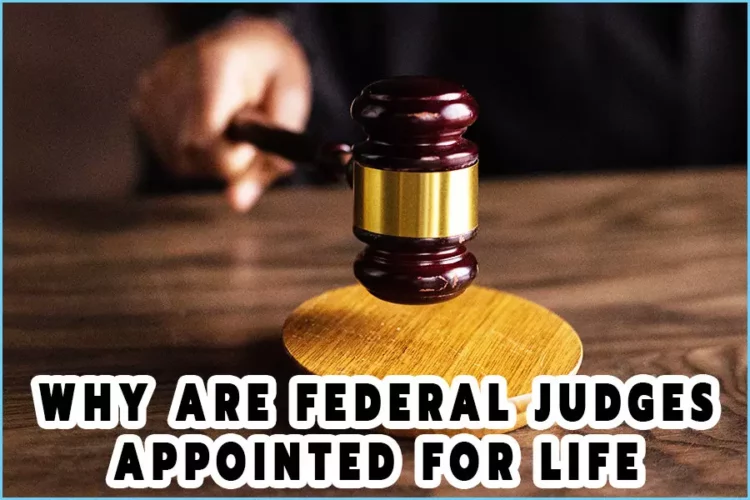There are not many jobs in the world with fixed terms. Even the U.S. President’s job isn’t fixed-term. After four years, a sitting president may decide to seek re-election to serve for another four years.
What about judges? Well, judges don’t have fixed terms. Once picked by the president and confirmed by the Senate, that’s it. They get to serve for life.
The only thing that ends a judge or justice’s tenure is retirement, death, or when convicted by the Senate.
Now, here is a popular question many have been asking about federal judges’ appointments and what you should know.
Why are federal judges appointed for life?
The reason federal judges are appointed for life is to enable them to discharge their duties without fear or favor.
The life appointment insulates U.S. judges and justices from public emotion. It enables them to discharge their duty without being affected by external pressure and political or electoral concerns.
As you already know, the U.S. President has the power to pick any candidate of choice for a federal judge position. But after choosing candidates, the Senate has to screen and select only one person for the job.
Keep reading as we discuss more on this subject.
How Are Federal Judges Picked?
Earlier, we offered a rundown on how federal judges are picked. Now, let’s elaborate on that and include what the U.S. Constitution says about federal judges’ appointments.
Well, firstly, federal judges are called Article III judges. Why? Article III established the judiciary arm of government.
Furthermore, Article III of the United States Constitution confers power on the Senate to determine the judiciary’s shape and structure. Congress determines the number of judges the Supreme Court should have.
In most cases, the Supreme Court can have up to nine judges. It has been the case since 1869. The court usually has one Chief Justice, while the rest will be Associate Justices.
So, if the Supreme Court has eight judges, one of them will be the Chief Justice, while the remaining seven will be the Associate Justices. That’s how the U.S. judiciary system operates.
A Handy Tip: The Supreme Court is the highest in the United States of America. It is also essential to know that the Constitution doesn’t determine the number of judges a Supreme Court should have. Congress has to decide that.
The good thing about being a federal judge is this. Judges don’t have to seek reelection, campaign, or lobby Congress to remain in their position. Once appointed, they’ll stay in that position for life.
So, how are federal judges picked?
Candidates considered for federal judge positions don’t need to conduct primary elections or ask the public for votes. The presidents decide the candidates they prefer for the post.
However, the president can’t just pick anyone and give them the federal judge’s office keys. The Senate has to screen the candidates and determine the best person.
Candidates under investigation or those who committed crimes may withdraw or face disqualification. In 1993, Judge Kimba M. Wood dropped out of the race to become attorney general, leaving Janet Reno the only candidate for the position.
What was Judge Kimba M Wood’s crime? There were reports that she hired undocumented immigrants to work as her nannies.
That offense made her withdraw from the race. It happened during Bill Clinton’s tenure as president.
Furthermore, the president cannot veto the Senate’s choice of Chief Judge of the Supreme Court. However, the judge picked for the job must be one of the candidates presented by the U.S. President.
Can A Federal Judge Be Evicted From Office?
Yes, judges can be removed from office. But remember that Article III, Section 1 of the U.S. Constitution says, “Judges shall hold their position during good behavior.”
What does this imply? Well, the impeachment of judges because of their ruling from the bench is not constitutional. In other words, judicial impeachment cannot be based on a judicial act.
Congress can only impeach a federal judge via ethical and criminal misconduct. Samuel B. Kent, a district judge, got impeached for sexual assault, making false statements, and obstructing an official proceeding.
Samuel B. Kent resigned before the Senate commenced an impeachment proceeding against him. Rolf Larsen, a Pennsylvania Supreme Court Justice, got evicted from office in 1994.
Why was Rolf Larsen removed from office? There were several charges against him. Here are the charges.
Larsen had asked a medical doctor to produce false prescriptions, improperly interacted with lawyers, including a trial judge on a case, and then lied under oath.
David Brock, New Hampshire Supreme Court Justice, was impeached by Congress for improper communication and lying under oath.
So, it is worth noting that judicial impeachment has been historically reduced to cases of serious criminal and ethical violations. The legislatures cannot just decide to evict a federal judge because they don’t like the person or for other political reasons.
If that were the case, we would have witnessed judges’ eviction now and then. It would have also created a toxic environment for judges and forced them to do the bidding of politicians.
Let’s look at Samuel Chase, a Supreme Court Justice’s attempted removal in 1804. His case shows how vital securing the type of judicial independence the U.S. judiciary system seeks today.
What inspired Justice Chase’s attempted removal? Well, Democratic-Republican and then United States President, Thomas Jefferson, had asked the House to impeach the Federalist, Justice Chase.
Jefferson wanted Justice Chase gone after his criticism of the president and several of his policies to a Baltimore grand jury.
The House honored Thomas Jefferson’s request and initiated impeachment proceedings against Justice Chase. The House claimed Chase’s partisan statement did undermine the judiciary. They also leveled several inflated charges of misconduct against the Supreme Court judge.
So, was Justice Chase impeached? Surprisingly, he got impeached by the House in 1804, but the Senate decided against convicting him the following year.
But then, Justice Chase’s declined conviction was a surprise. Why? Thomas Jefferson’s party had a supermajority in the upper house.
However, Justice Chase’s failed impeachment helped shape judicial impeachment power’s usage. It showed that removing judges based on judicial decisions could make the judiciary system infective, a move that is dangerous for our democracy.
At What Age Do U.S. Federal Judges Retire?
Federal judges are appointed for life. So, they don’t have a specific retirement time.
However, federal judges operating in the federal court system must be at least 65years before retiring. A combination of the judge’s age and active years in service should be 80 years.
Conclusion
Why are federal judges appointed for life? Appointing federal judges for life helps insulate them against any external pressure and helps them focus on the job.
The U.S. President nominates candidates for federal judge jobs. But Congress has to screen and decide who becomes Chief Judge amongst the candidates.
Furthermore, we also mentioned that federal judges could be evicted from office based on severe ethical and criminal convictions.
Additionally, the president doesn’t have the power to remove a federal judge, and legislatures cannot impeach a federal judge based on judicial decisions.










